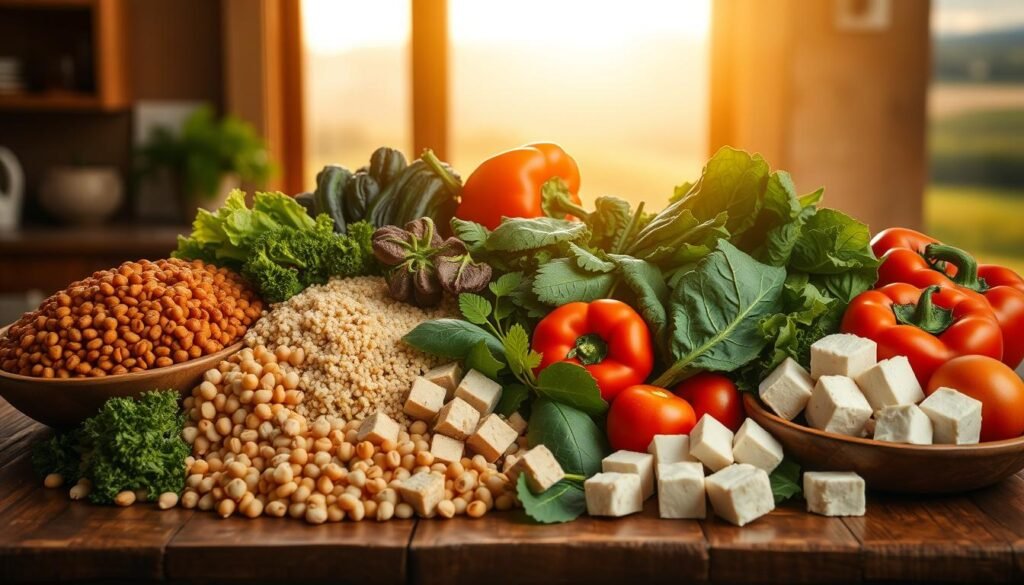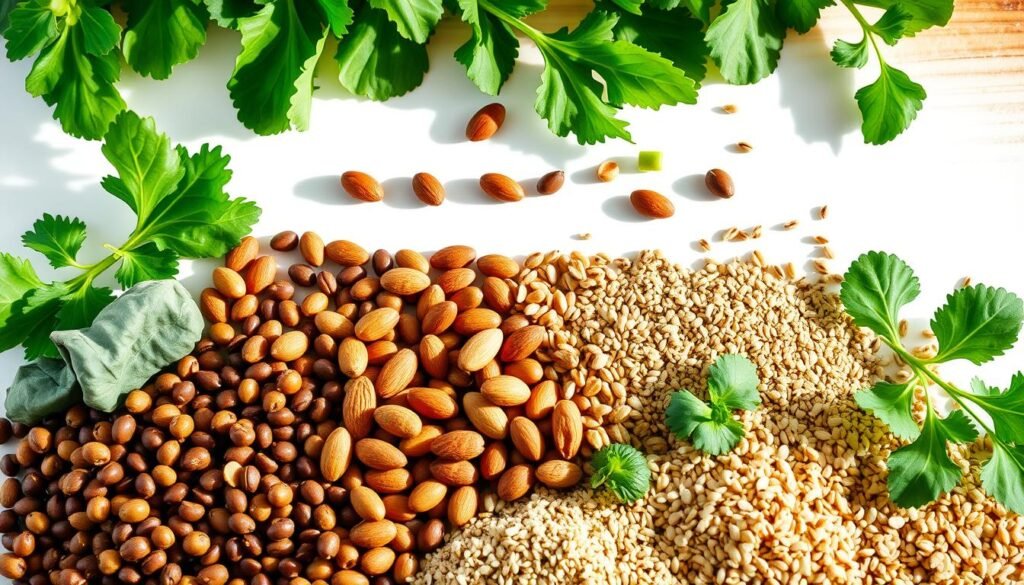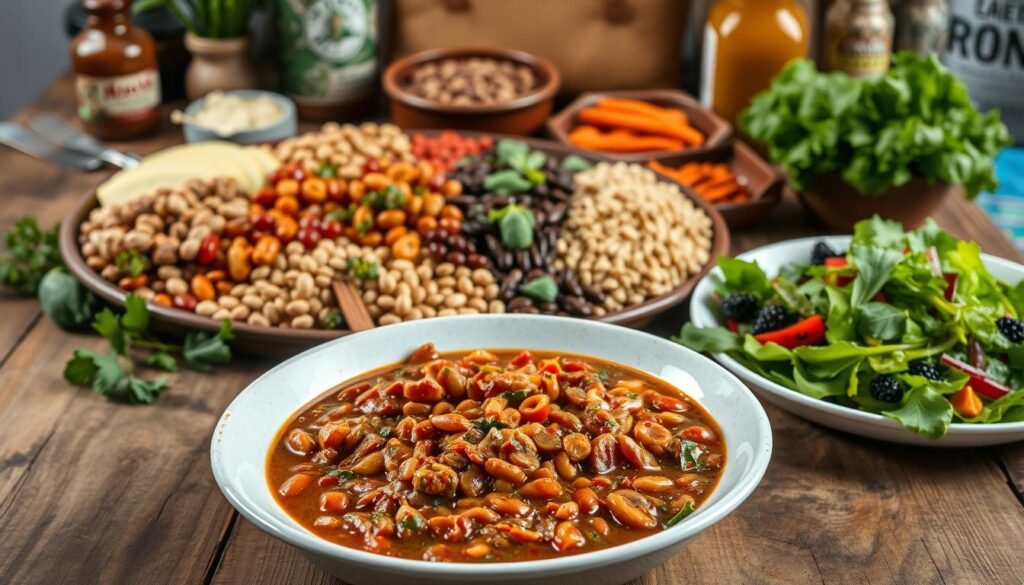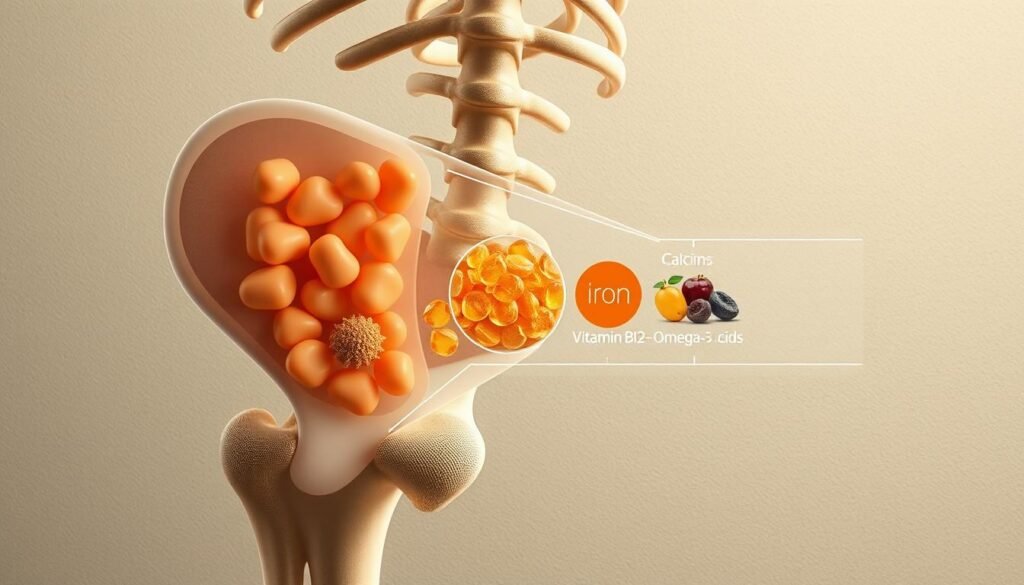Plant-Based Protein Sources: Maximizing Intake Without Meat

Eat well and lift smart — a plant-forward plan can fully support muscle repair, bone health, and body composition as people age. This guide links evidence-based advice on protein needs with practical steps that match an effective resistance routine done 3–4 days per week.
Harvard T.H. Chan highlights protein’s role in repair and overall health, and that context helps shape meal timing and portion choices here. Adequate protein at each meal fuels recovery as training volume and recovery needs change with age.
What this guide gives you: simple pairing tips for complementary proteins, leucine-aware choices, easy swaps, and cooking methods to boost digestibility. Expect a two-week plan for workout days, a U.S.-focused grocery guide, and smart habits to cut decision fatigue so you can stay consistent.
Key Takeaways
- Plant proteins can meet performance and metabolic goals when planned around meals.
- Protein timing and amount matter as recovery needs evolve.
- Progressive overload, form, and recovery remain the training backbone.
- Blue Zone patterns adapt well to higher-protein needs with whole foods.
- Practical tools and a grocery guide reduce friction for busy schedules.
Why Plant-Based Protein Matters When You Lift After Forty
Midlife brings changes that make protein a key daily habit to protect muscle, bone, and metabolism.
Hormonal shifts and a slower resting metabolic rate increase the need for dietary protein. Repairs take longer, and the risk of muscle loss rises with age. That makes daily protein a performance and recovery tool, not just a macro target.
Lifting stimulates muscle protein turnover and bone loading. Compound moves and progressive overload signal the body to preserve lean mass and boost bone density. Paired with adequate protein, workouts become safer and more effective.
Plant sources can deliver the same outcomes when you hit total grams, spread protein across meals, and mind amino acid profiles. A whole-food plant approach also supports heart and metabolic health while fueling activity.
- Protein aids repair, reduces injury risk, and helps maintain resting metabolic rate.
- Consistent exercise plus sufficient protein improves body composition and energy.
- Next, we’ll cover complementary pairings and leucine targets that matter for active adults.
| Benefit | How It Works | Practical Tip |
|---|---|---|
| Muscle repair | Protein supplies amino acids for synthesis after sessions | Distribute 20–35 g per meal from varied plant proteins |
| Bone health | Loading from compound movements plus collagen support | Include calcium-rich plants and protein post-workout |
| Metabolic maintenance | Lean mass preserves resting metabolic rate | Combine resistance work with daily protein targets |
Understanding Protein Needs for Active Women Over Forty
Moderate increases in daily protein and smarter meal timing help gym-goers preserve muscle and support bones.
Daily targets: Aim above the RDA—roughly 1.0–1.4 g/kg body weight per day for active adults—so a 150 lb person would target about 68–95 g daily. This range aligns with guidance that higher intake aids repair and bone loading when paired with 3–4 full-body sessions each week.
Per-meal strategy: Spread protein evenly across breakfast, lunch, dinner, plus a protein-forward snack. Target 20–35 g per sitting to stimulate muscle protein synthesis multiple times a day. Use hand-portion or plate methods: a palm-sized portion of a dense plant protein, a cup of legumes, or two tablespoons of nut butter.
Timing Around Workouts
Consume a small amount of protein 60–90 minutes before sessions if you train fasted. After workouts, aim for a 20–30 g plant-protein meal or shake within 1–2 hours to speed recovery and lock in gains.
- Keep calories steady on rest days but slightly reduce carbs if activity drops.
- Add a late small protein boost to aid overnight repair.
- Track per-meal protein to match sets, reps, and weekly frequency for progress.
| Goal | Practical Tip | Why it matters |
|---|---|---|
| Muscle maintenance | 20–35 g per meal | Supports muscle mass and workout quality |
| Bone support | Pair protein with calcium-rich plants | Improves loading response and long-term health |
| Digestion & energy | Hydrate and add fiber slowly | Enhances comfort and steady calories |
Protein Quality 101: Complete vs Complementary Plant Proteins
Not all plant proteins are identical; some supply every essential amino acid while others pair perfectly when combined.
Complete proteins contain all essential amino acids in sufficient amounts. Many soy products, quinoa, and buckwheat fit this definition and are useful after resistance sessions to support muscle repair and adaptation.
Complementary proteins are two or more plant foods that, when eaten together, create a full amino acid profile. Classic combos work well around workouts and daily meals.
Leucine threshold and muscle protein synthesis
Leucine is the amino acid that signals muscle protein synthesis. Aim for ~2.5–3 g of leucine per meal to hit the trigger point that supports gains from progressive overload and proper form.
Soy, lentils, and hemp seeds have higher leucine relative to many grains. Read labels and prioritize these when you want a compact, effective post-exercise meal.
Smart pairings and portions
- Rice + beans — 1 cup cooked rice + 3/4 cup cooked beans
- Hummus + whole-grain pita — 1/2 cup hummus + 1 pita
- Lentils + quinoa — 1 cup lentils + 1/2 cup quinoa
- Tofu/tempeh + buckwheat — 4 oz tofu + 1 cup cooked buckwheat
- Soy yogurt + hemp seeds — 6 oz yogurt + 2 tbsp hemp
Portions above typically deliver 20–30 g protein and meaningful leucine to support repair, help increase weight on key movements, and maintain lean mass.
| Pairing | Typical Protein (g) | Why It Works |
|---|---|---|
| Rice + beans | 18–24 | Complements limiting amino acids, easy to scale with portions |
| Lentils + quinoa | 22–28 | Quinoa adds methionine; combined product is near-complete |
| Tofu + buckwheat | 20–30 | Soy gives leucine; buckwheat boosts essential profile |
| Soy yogurt + hemp | 15–22 | Quick snack with a good leucine-to-protein ratio |
Practical tips: Rotate protein sources weekly, use soaking/fermenting to improve digestion, and swap almond milk for soy milk to add real grams. For more on amino acids and plant protein quality, see Harvard’s Protein guide.
Top Plant-Based Protein All-Stars to Stock Today
Stocking a pantry with dense plant proteins makes it easy to hit daily protein targets without meat.
Legumes and pulses are foundational. Keep lentils, chickpeas, black beans, and soy foods (tofu, tempeh, edamame, soy milk) on hand. Half a cup of cooked lentils gives ~9 g protein; 3/4 cup cooked chickpeas is ~11 g. Soy options offer a high amino profile useful after a workout.
Grains and seeds that boost per-serving protein include quinoa, buckwheat, hemp hearts, chia, and flax. Sprinkle 2 tablespoons of hemp on oats for ~6–7 g protein and added omega-3s.

Minimally processed proteins—plain seitan, sprouted tofu/tempeh, and unsweetened soy yogurt—work as quick meals or snacks. Nuts and nut butters (peanut, almond, cashew) add calories when training volume rises and help reach mass and recovery goals.
- Calcium-set tofu and fortified soy milk support bone health while raising protein intake.
- Buy dry beans, bulk seeds, and store brands to save money.
- Batch-cook beans, bake tofu, and pre-cook quinoa to save time on training days.
- Snack ideas: soy yogurt with hemp, roasted chickpeas, or steamed edamame pods.
| Food | Typical Serving | Protein (g) |
|---|---|---|
| Lentils (cooked) | 1/2 cup | 9 |
| Tofu (firm) | 4 oz | 10–12 |
| Quinoa (cooked) | 1 cup | 8 |
| Hemp hearts | 2 tbsp | 6–7 |
| Chickpeas (cooked) | 3/4 cup | 11 |
Quick tip: Rotate these staples across meals to hit per-meal leucine and protein targets. That consistency helps preserve muscle and supports metabolism while you follow a sensible exercise plan.
Meal-Building Frameworks That Hit Your Protein Targets
A simple plate model helps you hit protein targets while keeping meals balanced and easy to prep. Use the CDC healthy plate idea: half produce, one quarter high-protein plant foods, and one quarter performance carbs, plus a small amount of healthy fat. This “Protein-Produce-Performance” plate fuels efficient full-body sessions and recovery.
The “Protein-Produce-Performance” plate
Half produce for vitamins and fiber. One quarter dense plant proteins (tofu, tempeh, seitan, legumes). One quarter carbs that support performance (brown rice, quinoa, sweet potato). Add a drizzle of olive oil or avocado for calories and satiety.
Meal templates that scale
- Breakfast: tofu scramble + greens + whole-grain toast; or soy yogurt parfait with oats and hemp — great before a morning workout.
- Lunch/Dinner: lentil-quinoa bowl, tempeh stir-fry with brown rice and veggies, or black bean chili with corn and avocado.
- Snacks: steamed edamame, soy milk shakes, or hummus with whole-grain crackers — easy between sets and on busy days.
Scale portions up on higher-volume days by adding a spoonful of hemp, a seitan strip, or extra tofu to hit per-meal protein and the ~2.5–3 g leucine target. Time carbs around the workout to support effort and recovery.
| Focus | Quick tweak | Why it helps |
|---|---|---|
| Per-meal protein | Hemp, chia, seitan strips | Raises grams with little prep |
| Digestion | Raise fiber slowly, hydrate | Comfort as calories and protein rise |
| Flavor | Use herbs, citrus, low-sodium broths | Reduce excess sodium, keep taste |
Use short circuits in the gym—3 sets per movement, varied sets reps, and focus on compound moves with dumbbell work across major muscle groups and progressive overload. Meals built this way keep energy steady, support weight handling, and speed recovery.
Blue Zone-Inspired Eating for Strength, Longevity, and Metabolism
Blue Zone eating centers meals around simple, plant-forward dishes that support vitality across the years.
What these patterns get right: plant-centric meals, legumes as staples, whole grains, nuts, and home cooking. These habits promote cardiometabolic health, steady body weight, and steady energy that helps with long-term recovery and performance.
Practical tweaks to raise protein: prioritize soy foods, lentil-based stews, and seed toppers like hemp or pumpkin to boost leucine and calcium without complicating meals. Rotate tofu or tempeh into stir-fries and soups on workout days to hit per-meal targets.

Weekly rhythm and social routine
- Legume-heavy soups and grain-seed bowls twice weekly.
- Tofu or tempeh entrees midweek for concentrated protein.
- Shared meals and simple routines reduce decision fatigue and improve consistency.
| Blue Zone Habit | Why it helps | Protein tweak | Benefit over years |
|---|---|---|---|
| Legume staples | Low-cost, nutrient-dense | Add lentils, soy, or hemp | Supports muscle mass and metabolism |
| Whole grains & nuts | Slow energy, fiber | Mix quinoa or buckwheat; add seeds | Better weight stability and recovery |
| Home cooking | Control ingredients | Batch-cook protein-forward stews | Affordable, consistent intake |
| Mindful eating | Better digestion | Eat slowly, portion protein evenly | Improved recovery and long-term resilience |
Long-term benefits: Adapting Blue Zone simplicity to higher-protein meals preserves mobility, supports metabolism, and helps with healthy aging while staying affordable and practical.
Smart Swaps: Turning Favorite Dishes into Protein-Rich Plant Meals
Small swaps in the kitchen can turn familiar meals into reliable, higher-protein options that match your weekly workout and help rebuild muscle. These changes keep taste first and save time on busy training days.
Soup, salad, and bowl fixes
Add lentils, chickpeas, or diced tofu to soups near the end of cooking to keep texture and protein high. Toss edamame or tempeh bacon into salads with quinoa and a hemp-lemon dressing to raise grams without fuss.
Quiet add-ins and pantry swaps
Swap regular pasta for lentil or chickpea pasta. Stir in white beans, spinach, and nutritional yeast. Keep hemp hearts, roasted chickpeas, and baked tofu ready to top any plate after exercises.
- Silken tofu in smoothies
- Soy milk instead of almond milk
- Peanut powder in oats
| Dish | Quick swap | Protein boost |
|---|---|---|
| Soup | Lentils or chickpeas | +8–12 g |
| Salad | Edamame + quinoa | +10–15 g |
| Pasta | Lentil pasta + white beans | +15–20 g |
Taste-first tweaks make protein upgrades sustainable. Batch add-ins on weekend prep days so meals keep pace with your movements, sets, and other exercises while protecting calories and supporting overall strength of the body.
Grocery Guide: U.S. Pantry and Produce List for Protein-Forward Weeks
Stocking a compact, protein-first pantry makes meal prep fast on busy program days.
Pantry proteins: dried or canned lentils, chickpeas, black beans; tofu and tempeh; unsweetened soy milk and soy yogurt; seitan. These staples cover quick meals and packed lunches for training and rest days.
Grains & seeds: quinoa, buckwheat, brown rice, oats, whole-grain pasta, hemp hearts, chia, and flax. Add these to meals to boost per-meal protein and keep weight stable.
- Nuts & butters: peanut, almond, cashew; pumpkin seeds; tahini for sauces and snacks.
- Produce staples: leafy greens, crucifers, tomatoes, onions, peppers, sweet potatoes, bananas, and berries.
- Flavors & condiments: miso, tamari, nutritional yeast, spices, citrus, garlic, and ginger.
- Frozen convenience: edamame, mixed vegetables, pre-cooked brown rice, and frozen fruit for smoothies.
- Quick proteins: canned beans, shelf-stable tofu, and ready-to-eat lentil packets for busy workout or gym mornings.
Budget and storage tips: buy dry beans and grains from bulk bins, choose store-brand soy products, and favor seasonal produce. Batch-cook beans and grains, then refrigerate or freeze single portions to save time and reduce food waste.
| Category | Items to Buy | Why It Helps |
|---|---|---|
| Pantry Proteins | Lentils, chickpeas, black beans, tofu, tempeh, seitan | Reliable anchors across training and rest days; long shelf life |
| Grains & Seeds | Quinoa, brown rice, oats, hemp hearts, chia | Boosts per-meal protein and leucine when paired with legumes |
| Frozen & Convenience | Edamame, mixed veg, frozen fruit, lentil packets | Quick prep on busy program days; supports consistent routine |
| Produce & Flavor | Leafy greens, sweet potatoes, garlic, miso, tamari | Keeps meals varied, nutrient-dense, and easy to season |
Cooking Methods That Protect Protein and Boost Digestibility
Small changes in how you prep legumes and soy unlock better tolerance and steady protein intake.
Soak and sprout to reduce antinutrients and make beans easier to digest. Soaking overnight or sprouting cuts phytic acid without lowering usable protein.
Use a pressure cooker to finish beans quickly and tenderly. Batch-cook and freeze portions so meals are ready after exercises and busy days.
Fermentation, spices, and simple tofu fixes
Fermented soy—tempeh, miso—adds flavor and eases digestion. Add cumin, ginger, and fennel while cooking to calm the gut as you increase legumes.
For tofu, try baking, air-frying, or pan-searing to concentrate texture and protein per serving. These methods make tofu more versatile across the week.
“Digestibility-focused prep helps you distribute protein more consistently, which aids recovery and supports body composition goals.”
- Choose plain seitan or unsweetened soy yogurt on high-volume training days to fill gaps quickly.
- Read labels: avoid added sugars and excess sodium that undermine recovery benefits.
- Reheat gently, store in single-serve containers, and increase water and fiber slowly to limit GI changes.
| Method | Key Benefit | Quick Tip |
|---|---|---|
| Soaking/Sprouting | Reduces antinutrients; better digestion | Soak overnight; rinse well |
| Pressure cooking | Tender beans; saves time | Batch-cook and freeze portions |
| Fermentation | Improved flavor and gut tolerance | Swap tempeh or miso into bowls |
| Tofu methods | Better texture; more satisfying | Bake or air-fry for denser bites |
Micronutrients That Matter: Iron, Calcium, Vitamin D, B12, and Omega-3s
A food-first approach keeps meals practical while protecting bone density and energy as you adjust meal plans across the years.
Iron and absorption: Plant sources include lentils, beans, tofu, and dark leafy greens. Pair these with vitamin C foods—citrus, bell peppers, or tomatoes—to boost non-heme iron uptake.
Calcium and bone density: Choose calcium-set tofu, fortified soy milk or yogurt, tahini, and kale to support bones alongside regular resistance work. The CDC healthy plate model helps keep meals balanced.

When to use supplements and testing
Vitamin D is often low; get levels checked and use fortified foods, sensible sun exposure, or supplements if tests show deficiency. B12 requires routine supplementation on plant-forward diets—consider a daily or weekly dose per clinician advice.
Include ALA omega-3 sources—flax, chia, walnuts—and consider algae-based EPA/DHA if needed. Regular labs with a provider help catch gaps, especially during perimenopause and menopause when calcium and vitamin D needs rise.
“Aim for food-first choices, then use targeted supplements to close any proven gaps.”
| Micronutrient | Key plant sources | Practical tip |
|---|---|---|
| Iron | Lentils, tofu, spinach | Serve with vitamin C |
| Calcium | Calcium-set tofu, fortified soy | 2–3 servings daily |
| Vitamin D | Fortified milk, sunlight | Test levels; supplement if low |
Sample day: breakfast soy yogurt + chia; lunch lentil-quinoa bowl with bell pepper; snack walnuts; dinner tofu and greens with tahini. For context, see Harvard’s Protein page and Blue Zone patterns to align dietary choices with long-term health.
Mental Wellness Supports Nutrition Consistency
Daily stress and busy schedules quietly shift appetite and make consistent protein choices harder to keep. That effect is real: anxiety and stalled sleep can change hunger cues and disrupt meal plans that support recovery and body goals.
Stress, anxiety, and appetite:
Stress, anxiety, and appetite: mindful strategies that keep you on track
Acknowledge how stress blunts or spikes appetite. Use simple mindful-eating habits to slow down, notice fullness, and protect per-meal protein targets.
- Pause for a single deep breath before meals to reset appetite and reduce rushed choices.
- Anchor plates with an easy protein (tofu, beans, soy yogurt) so food decisions require less time.
- Accept imperfect days—consistency over weeks beats perfection each day.
Digital detox and mindful eating:
Digital detox and mindful eating to reduce decision fatigue
Reducing screen time around meals cuts distraction and supports shopping decisions. Try short digital breaks on busy days to simplify meal prep and planning.
“Small routines—prep, lists, and protein anchors—make good nutrition automatic when stress rises.”
| Quick tactic | Why it helps | When to use |
|---|---|---|
| Five-minute meal prep | Reduces decision time at dinner | After workouts or busy days |
| 2-minute breathing | Resets appetite and mood | Before meals or workouts |
| Shopping list with protein anchors | Limits impulse buys | Weekly grocery days |
When anxiety limits daily function, seek professional support. Evidence shows regular movement improves mood and sleep, so pairing simple mental health strategies with steady workouts and planned protein intake gives lasting benefits.
Tech That Helps: Evidence-Informed Digital Tools for Habits
A few focused apps and timers can keep meals, workouts, and recovery aligned. Digital tools make scheduling batch-cooking, grocery runs, and rest days easier. They also help you log progress across a multi-week program.
Evidence: A 2024 JMIR Mental Health review shows digital habit tools improve adherence when they are simple, personalized, and privacy-aware.
Journaling, reminders, and meal-planning apps that simplify protein goals
Use habit trackers to set protein targets per meal and per day so your nutrition matches session demands. Tag entries to link meals to a specific workout or rest day.
- Calendar reminders for weekly batch-cooking and grocery trips keep the routine steady.
- Meal-planning apps with macro visibility confirm protein distribution across sets and sessions.
- Progress journals log perceived effort, workout details, and post-workout meals to spot patterns over time.
- Set timers for focused cooking sprints to save time and reduce friction.
- Pair wearable prompts with hydration and pre-lift snacks to avoid underfueling on gym days.
“Digital tools work best when they reduce cognitive load—choose small, reliable apps and export data to share with a coach or clinician if useful.”

| Tool type | Primary use | Quick tip |
|---|---|---|
| Habit tracker | Daily protein checks, streaks | Set simple wins (meal target reached) |
| Meal planner | Macro visibility and shopping lists | Lock recipes for batch-cook weeks |
| Journal / log | Workout notes, perceived effort, meals | Export monthly for program reviews |
| Timers & wearables | Prep sprints, hydration reminders | Use subtle alerts to avoid distraction |
Privacy tips: pick apps with minimal data collection, disable unnecessary syncing, and use exports instead of cloud storage when possible. Remember: tech should support habit formation, not create extra chores. Paper logs remain an equally valid option for steady progress.
Strength Training Fueling: Pre-, Intra-, and Post-Workout on Plants
Fuel choices before and after gym visits shape how well you finish sets and bounce back the next day.
Quick options for early-morning lifts and lunchtime sessions
Early-morning: keep pre-workout snacks light—soy yogurt with fruit or a banana with peanut butter. A small tofu wrap or a soy milk latte with oats works if you need a bit more.
Midday sessions: choose a balanced pre-meal (soy smoothie plus a slice of toast) and a moderate post-meal to recover without excess calories.
Carb-protein synergy for performance and recovery
Combine carbs and protein to refill glycogen and trigger muscle repair. Post-workout meals: tofu veggie stir-fry with rice, lentil pasta with tomato and spinach, or a soy smoothie with oats. These blends support muscle protein synthesis and fast recovery.
- During longer workouts, sip water with electrolytes and use simple carbs (banana, sports gel) to sustain effort.
- Portable picks: shelf-stable soy milk, roasted chickpeas, soy jerky, or protein oat bars for gym trips with dumbbell work.
- Low-appetite days: smoothies, blended soups, or soft tofu bowls provide protein without heaviness.
Practical tips: watch sodium and electrolytes in hot conditions. Test small meal variations to see what fits your sets and reps. Consistent fueling across training days helps progression, recovery, and safe increases in weight.
“Refer to Harvard’s Protein guidance for context on protein digestion and quality when planning plant-based pre- and post-workout meals.”
Main Keyword Focus: strength training for women over 40, lifting for women
Progress relies on a steady plan that pairs small load increases with smart recovery and food.
Progressive overload means adding a little more weight or a rep every week so your muscles adapt without excess fatigue. Aim to gradually increase weight or reps in tiny steps and keep form strict.
How to structure a month
- Start with 3 full-body sessions per week using compound moves: squats, rows, presses, deadlifts.
- Example progression: add 1–2 reps to squats week 1 and 2, then add a 1–2 lb plate or small dumbbell increase in week 3.
- Use the same pattern for rows and presses—track sets and reps and nudge load conservatively.
Plan one or two deliberate rest days to protect joints and connective tissue. Insert a deload week every 4–6 weeks to restore energy while keeping movement patterns.
| Focus | Action | Why |
|---|---|---|
| Plateaus | Change tempo or swap an exercise | Stimulates muscle without extra load |
| Technique | Film lifts or check with a coach | Refines form and prevents injury |
| Nutrition | Raise protein and carbs on intense weeks | Supports recovery and increases weight safely |
“Log sets, reps, and load—objective data builds confidence and prevents guesswork.”
Tip: Track short-term progress in a simple log, prioritize sleep, and distribute protein across meals to fuel quality work during sets and speed recovery after each workout.
Common Pitfalls When Going Meatless for Muscle—and How to Fix Them
Skipping a plan when you switch to plants often causes preventable setbacks in weight training and recovery. Simple fixes keep workouts productive and reduce pain during movement.
Quick fixes:
- Under-eating protein: pre-plan protein anchors each meal and use complementary combos to hit targets.
- Relying on ultraprocessed substitutes: favor tofu, tempeh, beans, and seitan most days for better nutrition.
- Digestive discomfort: soak or sprout legumes, raise fiber slowly, and hydrate.
- Skipping rest: schedule rest days and active recovery to ease pain and help recovery.
- Inconsistent training: commit to a realistic routine—three weekly sessions—and track progress.
Also watch form. Prioritize technique with lighter loads at first and seek occasional coaching to protect muscle groups and avoid chronic pain.
| Pitfall | Why it matters | Fix |
|---|---|---|
| Micronutrient gaps | Can harm bones and energy with age | Add fortified soy milk, calcium-set tofu, B12, iron + vitamin C |
| Monotony or sudden big changes | Leads to dropout or GI issues | Rotate proteins and phase in diet and training changes |
| Goal mismatch | Blocks progress in strength or composition | Align meals and training blocks to short-term goals |
“Phased, simple adjustments beat all-or-nothing shifts—plan meals and rest so gains stick.”
Putting It All Together: A Simple Two-Week Plant-Protein Plan for Training Days
A focused two-week plan pairs three full-body sessions with simple meal templates to keep protein steady and progress measurable.
Two-week calendar and routine
Week 1 & Week 2: Mon/Wed/Fri — 45-minute workouts (compound moves: squats, hinge, push, pull, core).
Rest days (Tue/Thu/Sat) include light walking or mobility. Sunday is batch-cook and meal prep time.
Daily meal templates (training days)
Breakfast: soy yogurt + oats + hemp. Lunch: mason-jar lentil salad with quinoa. Snack: soy milk smoothie or soy yogurt cup with fruit. Dinner: tempeh stir-fry or chickpea pasta bowl.
Batch cooking and packables
- Sunday steps: cook beans, quinoa, bake tofu, chop vegetables, mix vinaigrettes.
- Packable options: mason-jar lentil salads, tofu grain boxes, soy yogurt cups with oats and hemp.
- Time-saving dinners: sheet-pan tempeh stir-fry kits, chickpea pasta, black bean tacos that double as Monday lunches.
Pairing workouts and recovery meals
Squats/hinge days: post-workout lentil-quinoa bowl + roasted veg. Push/pull/core days: tofu stir-fry with brown rice or a soy smoothie with oats if appetite is low.
| Focus | Example post-workout meal | Quick tweak |
|---|---|---|
| Squats / hinge | Lentil-quinoa bowl with tahini | Extra hemp hearts |
| Push / pull | Tofu stir-fry with brown rice | Add edamame |
| Core / accessory | Chickpea pasta + spinach | Top with pumpkin seeds |
Micro-progression and logging
Use simple logs: record sets and reps each session and nudge reps up by 1–2 per set week-to-week. If reps hit the top of your range, add small weight or extra set the next week.
Home vs gym and travel adjustments: swap dumbbell moves for bodyweight or resistance-band variations. Keep protein distribution by using shelf-stable soy milk, canned beans, and ready tofu packets when traveling.
“Batch-cook once, assemble fast, and log sets to keep the program consistent while protein stays on target.”
Conclusion
Small, consistent changes to meals and movement drive the biggest gains over months, not days. ,
Plant-based protein can fully support progress, recovery, and long-term health when paired with 3–4 weekly sessions of compound work, good form, and gradual overload. Spread protein across meals, use simple Blue Zone-style tweaks, and favor digestible prep to reduce friction.
Mindful habits, basic tech tools, and routine check-ins with a clinician or dietitian protect micronutrient status and keep you on track. Start this week: plan your next three protein-forward meals and your next three workouts, then show up. Sustainable wins over time transform body composition, mood, and independence.





